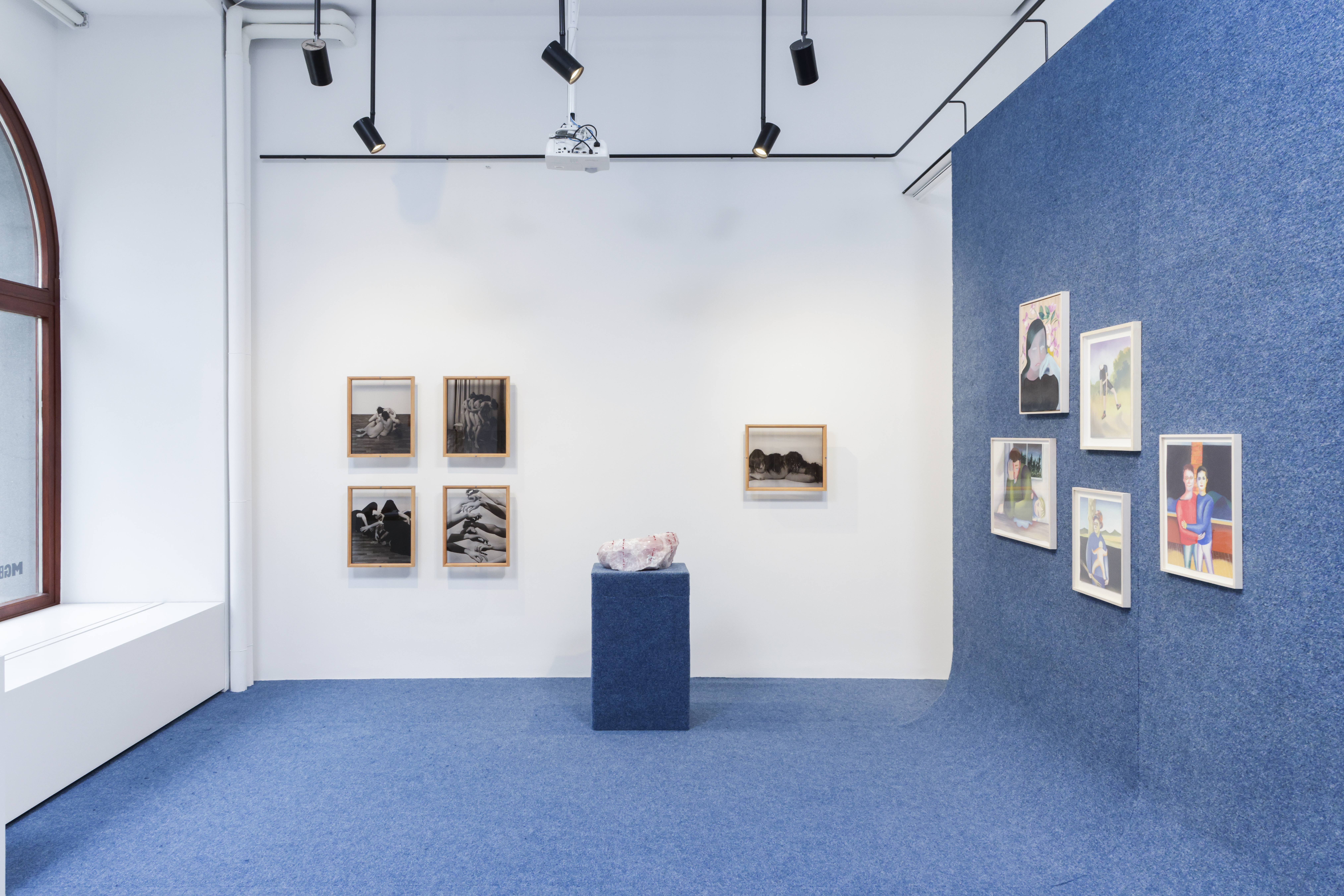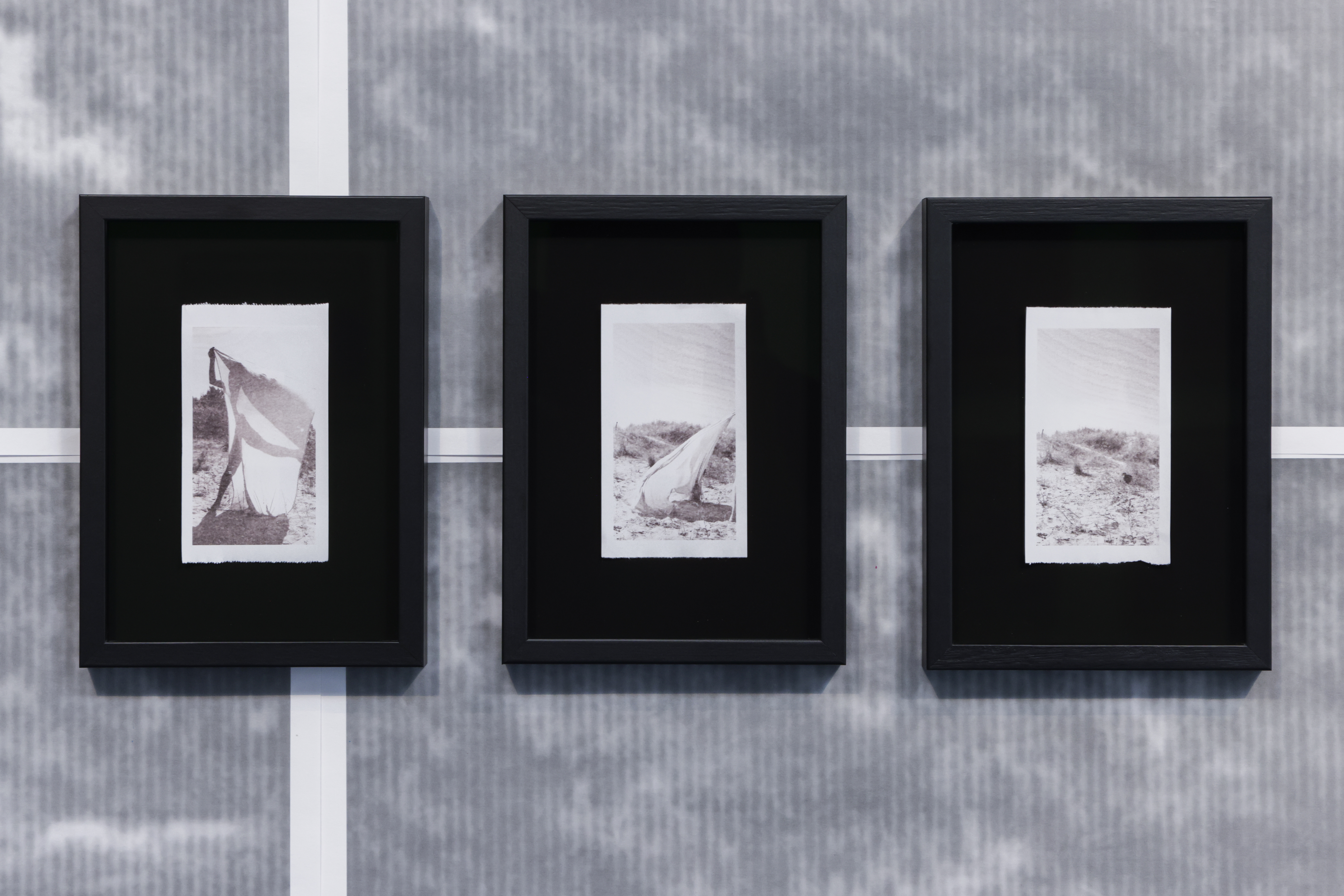ETC.: Comfort Zone: Displays of Affection
22. 5.–21. 6. 2025
Mala galerija BS, Ljubljana, Slovenia
Artists: Martina Drozd Smutná, Kaja Upelj, Dorottya Vékony, Sonja Vulpes, Konstantin Zhukov
All photos: Marijo Zupanov
More often than not, we are encouraged to step out of our comfort zone, assuming there is something better waiting on the other side. The perspective that “growth begins where your comfort zone ends” is echoed endlessly in self-help books and online, with influencers telling us how to be ambitious, push boundaries and self-improve. It takes courage and strength, we hear, and there is always a fair amount of risk in exchanging comfort for what is unknown but supposedly better. In times of permanent crisis, however, can we really assume a position of comfort is one to be taken for granted? Isn’t the unknown and the unstable more akin to our everyday experience than the idea that we might choose to live safely and predictably? On the contrary, we find that seeking or creating comfort is a struggle in itself for many and one that can be considered just as brave and demanding as jumping into the unknown.


The exhibition Comfort Zone: Displays of Affection is based on the fourth issue of ETC. magazine. Through works by Martina Drozd Smutná, Kaja Upelj, Dorottya Vékony, Sonja Vulpes and Konstantin Zhukov, it explores the notion of seeking out comfort in (public) displays of affection – both towards others and oneself. The artists in the exhibition thus reflect on the complexities and ambiguities of interpersonal relationships, intergenerational trauma, intimacy and sexual fluidity, gender roles and parenting challenges, as well as the importance of self-love.


In the series of prints Cake (2024), Sonja Vulpes continues her ongoing exploration of mental states, delving into the nuanced themes of self-love, personal reflection and the act of recognising and celebrating oneself. Through motifs of self-portraiture, cakes and flowers, the artist draws upon her childhood memories and feelings around birthday celebrations as moments that evoked unburdened happiness and a sense of boundlessness. The familiar symbolism is reimagined to convey self-appreciation, which can otherwise be difficult to express through visual form. The narrative unfolds through two intertwined approaches – a series of screenprints featuring a photograph from the artist’s childhood and self-portraits from the present. The second part includes collagraphs that weave together distinct elements of the cake — such as slices, icing, and crown — with figurative components to portray a person imbued with feelings of self-acceptance and love, capturing the artist’s impulses and playful interaction with the personified object.
![]()

The work Dear Veronika (2024) by Kaja Upelj examines the complexities and ambiguities of motherly as well as grandmotherly love and affection. She contemplates family bonds and intergenerational trauma carried from one woman to another while gradually reclaiming the colours, materials and patterns that due totheir association with femininity, have been traditionally perceived as fragile or even weak, and connecting them instead with strength and endurance. The work is inspired by Kaja Upelj’s own family dynamics, which are marked by a woman’s internal conflict in understanding what it means to be a mother and how a mother shows her love. The work is dedicated to the artist’s grandmother, a tough and independent woman who rarely showed emotion, as being emotional could be considered too feminine and too weak. This also meant withholding physical affection and tenderness and finding other ways to convey love to her children.

Dorottya Vékony is interested in issues of (in)fertility and reproductive rights. She looks at both questions related to abortion and the often traumatic experience resulting from miscarriages and infertility. While opposing the heteronormative model of the nuclear family, her inclusive art practice also extends to queer communities, antinatalists and those choosing not to have children for other reasons. One of the goals of her work Rites of Letting Go (2023) is to explore tabooed experiences and their impact on our self-image, as well as legal and medical alternatives to biological reproduction and heteronormative gender roles. Vékony has been personally involved in workshops, discussions and community rites related to infertility issues. Within the presented project, she arranged re-enactments of fertility rites, explored symbols referring to the cyclical nature of life and gestures of liberation from the self.



In the series of paintings Hold Me Tight (2020–2025), Martina Drozd Smutná views the family as a system where care is privatised, exposing how gender roles, fragile masculinity, and parenting challenges enter into a lack of broader support. Fragmented and reassembled human bodies reflect the dynamic yet intimate nature of family, kinship, and romance. The mysterious figures in Martina Smutna’s paintings appear melancholic, exhausted, and overwhelmed by their circumstances, but at the same time, emphasise the fundamental role of care, resilience, and independence. Through their struggles, they seek to overcome social hierarchies shaped by a broader sociopolitical context and highlight the importance of various community support networks.
Konstantin Zhukov’s project’s title, Black Carnation (2024), is a reference to the term used to refer to gay men in the Latvian gossip press before the Soviet occupation. With the censorship-heavy Soviet period being the biggest blind spot in queer history of the region, the term was subsequently lost and we don’t have any information of its origins or day-to-day use. Anonymous bodies and mute interactions are captured by Zhukov at a historic cruising beach a short train ride away from Riga. The irreversibly disappearing images – owing to the process of thermal printing onto the same receipt paper used for train tickets – speak to the state of Latvia’s queer archives and to the nature of memory itself; a transience, a softness, a fuzzy edgedness. These images will fade irreversibly over the exhibition time, as many past queer identities and their stories have disappeared into the historical void.






Curated by: ETC.
Exhibition Design: Žan Kobal, Timotej Rosc
The exhibition is supported by the Ministry of Culture of the Republic of Slovenia, the City of Ljubljana, the Liszt Institute Ljubljana and the Embassy of the Republic of Slovenia in Riga.
Exhibition Design: Žan Kobal, Timotej Rosc
The exhibition is supported by the Ministry of Culture of the Republic of Slovenia, the City of Ljubljana, the Liszt Institute Ljubljana and the Embassy of the Republic of Slovenia in Riga.
Etc. is a annual magazine, dedicated to showcasing current artistic production from the Baltic to the Balkans.
Based in Ljubljana, Slovenia, each issue is dedicated to a relevant topic in art and life. Founded to promote emerging artists, its goal is to initiate a dialogue, inspire collaborations, and challenge set views.